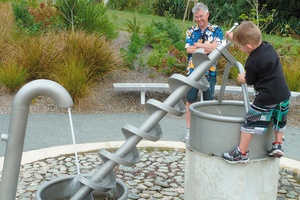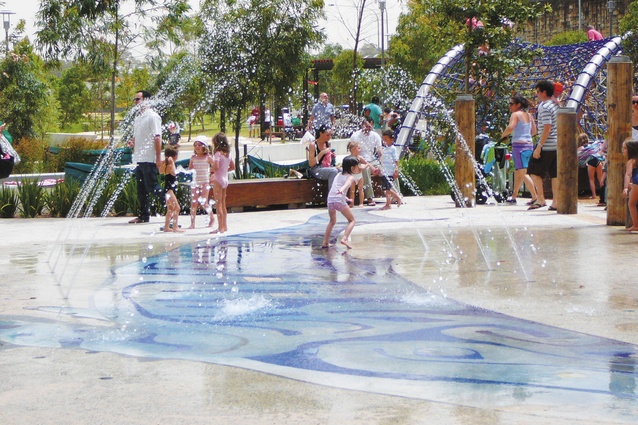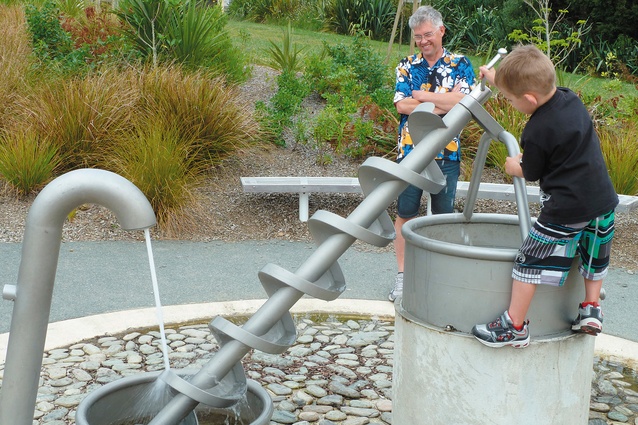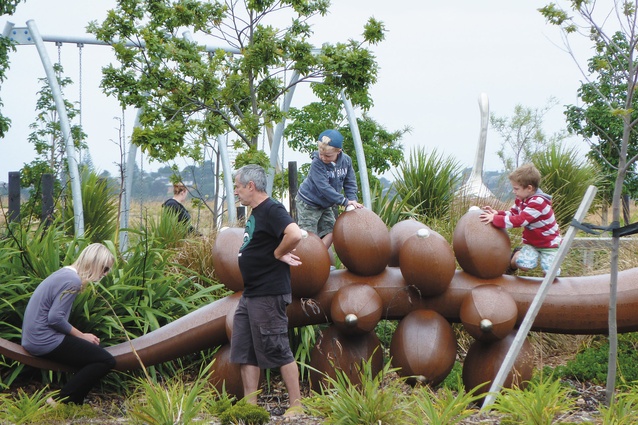Graft union in the playground
Where should the children play? Sue Wake offers a bouquet to designers that have attempted to transform playgrounds from barren and plantless to places of intrigue, education and fun.
Bringing cambium (actively dividing) layers of cells together between two closely related plants can lead to the formation of a graft union, a moulding of two living things that confers advantages to each. Like bringing together children and plants, a fusion happening in some new playgrounds I’ve visited. This article follows an earlier one (Landscape New Zealand, May 2008) in which I applauded what I detected as the beginnings of this encouraging movement. In this episode, I’m proposing these playscapes could instead be called ‘play gardens’ and why such spaces may contribute to young people’s wellbeing and even to their future environmental attitudes.
Since formal playgrounds with purpose-built equipment first appeared in the early 20th century, their representation as barren, plantless landscapes has persisted. Enclosed playgrounds were originally a device that marshalled and controlled children and their behaviour. Although touted as protecting and socialising them, as well as improving their fitness (so they would make better soldiers when war came) they effectively separated children from engagement with nature or, in the city, from the wider urbanscape. ‘Stranger danger’ was always a paranoia that precluded taller plants, since they could encourage lurking by undesirable people. Even in early 1900s New Zealand, locked gates and playground assistants were deemed necessary to protect children against such potentially menacing elements. In more recent years we have sought to protect children from themselves, providing softfall to prevent broken bones, despite research suggesting the importance of children learning to assess risk even at the cost of a few weeks in a cast.

But my focus here is encouraging and congratulating designers on the integration of both plant material and greater free-play opportunities within the traditional playground model.
There is plenty of research pointing to the importance of children’s engagement with nature for health reasons (physical and psychological) as well as for the future of the planet in terms of developing positive attitudes and behaviour towards the environment. Cheryl Greenfield, early childhood researcher from MIT, emphasises that children need to have contact with nature and the natural and wider world, listing as examples for inclusion in outdoor play environments: stepping stone trails, varying levels, gardening, water, sounds, sand for digging and insects.1 It is impractical to offer totally hands-on plant experiences in a public playground situation but to exclude them completely from outdoor play experiences sends a pretty clear message to children that they aren’t important.
When I wrote State of Play in 2008, examples included Stancombe Park in Manukau, with its wetland and bird hide theme, and the Marble Garden at Lord Elsmore Park. Both illustrate an exciting new way of designing playgrounds that actively incorporate plants as part of the experience as well as encouraging play that is much more creative than static playground equipment alone can provide for. I therefore suggest using the term ‘play garden’ for these spaces. I returned to Stancombe Park recently and was impressed with how the plants have established, especially within the sunken rain gardens. In addition the wetland in the surrounding Barry Curtis Park has now been constructed, which connects the play garden to the wider environment and gives greater purpose for the binoculars in the bird viewing towers. The distinct separation of the play area into static play equipment in one place and more imaginative play with bird hides and pukeko bird and nest sculptures in another seems a little disconnected, but as a pioneering example of departing from the traditional playground model, it is a credit to Isthmus Group.
The possibility of not only incorporating plants within the playscape so they become part of the experience, but also inviting learning through use of sculpture, models and things to manipulate, is a step further. For example, the new Hobsonville Point play garden, also by Isthmus, has play equipment beautifully integrated among the interesting garden trails that reference plant roots, and giant corten and stainless steel sculptures of fruits that invite climbing or sitting. Isthmus clearly aims to educate about seed dispersal; the sculptures are situated among plantings of that particular species, and there is some subtle interpretational text, although it is hard to see. As at Stancombe Park, I did find myself wishing for a simple sign that gave some explanation about the theme (so parents can read and explain to their children), however in terms of luring you from a distance the tall fort structure, which is modelled on fantail nests, is very effective.
Water play is a popular element to include for children and is now being used creatively in many play gardens. Australia is perhaps leading the way; impressive ventures include Sydney’s Darling Harbour playground, which has nearly half a hectare devoted to an interactive water feature. Also in Sydney, the play garden at Pirrama Park, on the former Water Police site at Pyrmont, was designed by Fiona Robbe of Architects of Arcadia. Referencing the history of the waterfront area as a once heavily vegetated peninsula and later an area of quarries and workers, the playscape includes plenty of trees and planting amidst integrated water, sand, wood and stone play opportunities. Back home, and typically on a more modest scale, the Archimedes screw-inspired water play at Schnapper Rock play garden in Albany (by LandscapeWorks) is fun and educational for all ages and the play equipment is also well integrated within the planting and other activities such as a swing bridge and stepping stones. A further bonus is the wider age range catered for, with mounds for biking provided down a slope and a playing field with bounce-back soccer goals.
Play equipment can be a design star in its own right, as evidenced in a recent article about play environments for the technological age that are designed to compete against computer games for kids’ attention (Popular Science, 2012)2. But play equipment alone can create stark and contrived environments that are limited in imaginative use, numbers and ages of children, natural environment experiences and learning potential. Integration with plants, paths and other activities leads to a more natural and creative experience. It also signals to children and youth that plants and organic materials are a natural part of outdoor play and experiences. Metaphorically grafting children with plants is a playground opportunity not to be missed and we are beginning to grasp it with the design of play gardens. Our next challenge is involving young people more in the design of these spaces – and that is something worthy of wrapping our creative brains around.













